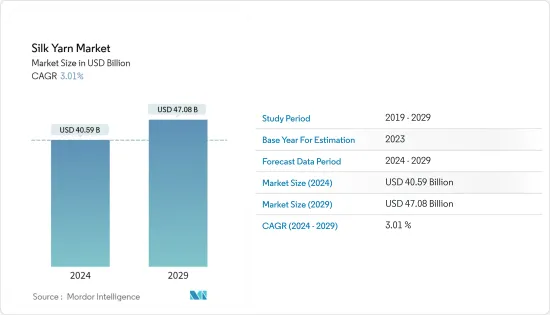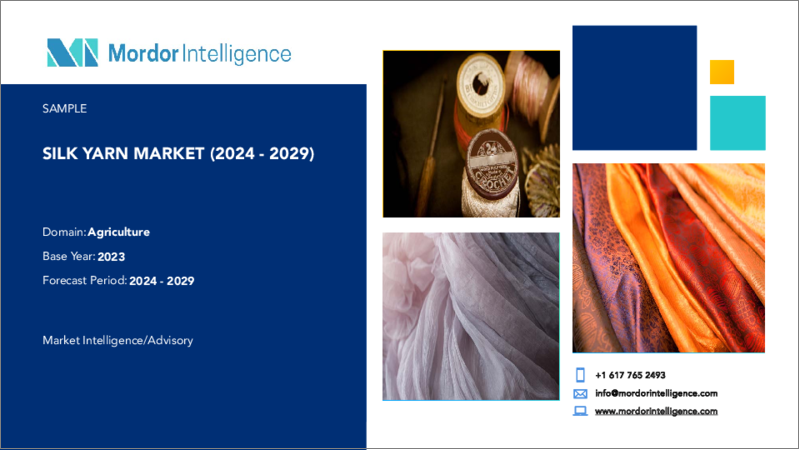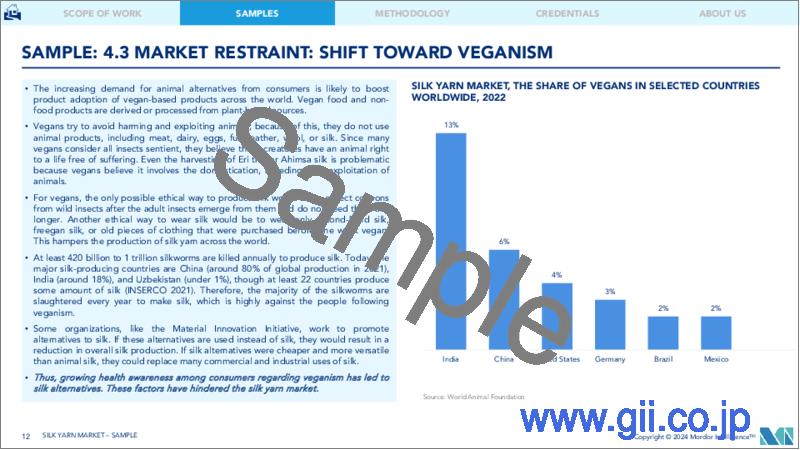|
|
市場調査レポート
商品コード
1439771
絹糸:市場シェア分析、業界動向と統計、成長予測(2024-2029)Silk Yarn - Market Share Analysis, Industry Trends & Statistics, Growth Forecasts (2024 - 2029) |
||||||
カスタマイズ可能
適宜更新あり
|
|||||||
| 絹糸:市場シェア分析、業界動向と統計、成長予測(2024-2029) |
|
出版日: 2024年02月15日
発行: Mordor Intelligence
ページ情報: 英文 80 Pages
納期: 2~3営業日
|
全表示
- 概要
- 目次
絹糸市場規模は2024年に405億9,000万米ドルと推定され、2029年までに470億8,000万米ドルに達すると予測されており、予測期間(2024年から2029年)中に3.01%のCAGRで成長します。

主なハイライト
- さまざまな政府の計画と相まって、絹産業の工業化により、アジア太平洋地域の生糸の生産が増加し、ひいては絹糸の生産が増加し、この地域が予測期間中に最大の市場となるでしょう。
- キューバなどのカリブ海諸国やケニアなどのアフリカ諸国は、絹糸の生産拡大に取り組んでいます。ルワンダ政府も同様に、アジアからの需要の高まりを受けて、高品質の絹糸の生産が行われるシルクバリューチェーンの開発への投資を開始しています。-高品質のシルク製品は強力な輸出機会を提供します。成長する世界市場を開拓するために、ルワンダの国家農業輸出開発委員会(NAEB)も韓国のシルクメーカーであるHEWorksと提携しました。
- この部門はインドなどの国々で外貨準備の主要な供給者であるため、政府は業界を活性化するためのさまざまな取り組みを支援しています。インドでは、52,360の村で養蚕が行われています。この国は、シルクの衣類、化粧品、織物、糸、カーペット、ショール、スカーフ、枕カバー、アクセサリーの製造に原材料を使用しています。
- インド、中国、米国、イタリア、フランス、スイス、日本、ベトナム、アラブ首長国連邦、英国、ドイツ、韓国などの国々がシルクおよびシルク製品の主要消費者となっています。さまざまな政府の計画と相まって、絹産業の工業化により、アジア太平洋地域の生糸の生産が増加し、ひいては絹糸の生産が増加し、この地域は予測期間中に最大の市場となるでしょう。
絹糸市場動向
イタリアは欧州の絹糸の主要生産国として台頭中
イタリアは欧州地域における絹糸の主要生産国の一つであり、ここ数年で数百もの農場が蚕の飼育を始めています。イタリアで栽培された蚕を使った絹の生産は近年増加傾向にあります。 ONGETTA SRLなどの企業はシルクのスロースティングに特化しており、ONGETTA BIO SILKというブランド名でGOTS認定のオーガニックシルクを生産しています。欧州初のGOTS認証絹糸の紡績・撚糸工場でした。
中国からの絹糸輸出の減少により、イタリアの絹糸生産者は世界市場へのアクセスがさらに増える可能性が高いです。さらに、中国の絹の価格は上昇しており、イタリア産の蚕からイタリアで生産される絹糸の価格をはるかに上回っています。そうすれば国産蚕糸はさらに伸びると思われます。
しかし、イタリアの絹糸の生産と輸出は、中国の絹糸の生産と輸出に比べれば微々たるものです。 2021年、イタリアは世界に1,821万4,000米ドル相当の絹糸を輸出しました。これは2020年と比較して8%増加し、主な輸出先はフランス、ルーマニア、英国、オーストリア、ドイツでした。
アジア太平洋地域が市場を独占
中国は、絹および絹糸を含む絹製品の世界最大の生産国であり、輸出国でもあります。しかし、桑栽培のコスト上昇により、多くの農家が養蚕からの撤退を余儀なくされています。絹は主に長江デルタ南部で生産されています。有名なシルク生産地は、江蘇省、浙江省、四川省です。蘇州、杭州、南京、紹興などの都市は絹産業でよく知られています。
ウズベキスタンもシルクの著名な生産国です。この国の絹製品は世界市場で高く評価されています。国内では最近、「ウズベキパクソアト」という組織が設立されました。同団体は、蚕の繭生産や絹織物の加工・製造の改善に取り組んでいます。地元および世界中の製造業者との協力が進行中であり、自営業の絹生産者が奨励され、サポートされています。ウズベキスタンは中国、インドに次ぐ世界第3位のシルク生産国です。
インドは、生糸の輸入を削減するために国産絹の品質と生産性を向上させるために、中央シルク委員会(CSB)を通じてシルク・サマグラと呼ばれる計画を実施しています。オリッサ州のタッサーシルク栽培を促進するために、カディ・村産業委員会(KVIC)は最近、同地区のチョウドワールに州初の絹糸生産センターを設立しました。政府のさまざまな計画と相まって絹産業の産業化は、アジア太平洋地域では生糸の生産が増加し、これにより絹糸の生産が増加し、この地域は予測期間中に最大の市場となります。
絹糸産業の概要
その他の特典
- エクセル形式の市場予測(ME)シート
- 3か月のアナリストサポート
目次
第1章 イントロダクション
- 調査の前提条件と市場の定義
- 調査範囲
第2章 調査手法
第3章 エグゼクティブサマリー
第4章 市場力学
- 市場概要
- 市場促進要因
- 市場抑制要因
- バリューチェーン分析
第5章 市場セグメンテーション
- 地域(生産分析、金額・数量別消費分析、金額・数量別輸入分析、金額・数量別輸出分析、価格動向分析)
- 米国
- 中国
- インド
- タイ
- ドイツ
- イタリア
- 英国
- ブラジル
- チュニジア
第6章 市場機会と将来の動向
The Silk Yarn Market size is estimated at USD 40.59 billion in 2024, and is expected to reach USD 47.08 billion by 2029, growing at a CAGR of 3.01% during the forecast period (2024-2029).

Key Highlights
- The industrialization of the silk industry coupled with various government schemes will boost the production of raw silk in the Asia-pacific region which in turn increase the production of silk yarn making the region to be the largest market during the forecast period.
- Caribbean countries such as Cuba and African Countries including Kenya are making an effort to boost their silk yarn production.The Government of Rwanda as well as has begun investing in the development of silk value chains, with the rising demand from Asia, the production of high-quality silk products offers strong export opportunities. To tap into growing global markets, Rwanda's National Agricultural Export Development Board (NAEB) has also partnered with HEWorks, a Korean silk manufacturer.
- The sector is a major provider to foreign exchange reserves in nations such as India which is why the government supports with various initiatives to boost the industry. In India, sericulture operations are distributed throughout 52,360 villages. The country uses raw materials to manufacture silk garments, made-ups, textiles, yarns, carpets, shawls, scarves, pillow coverings, and accessories.
- Countries such as India, China, the United States of America, Italy, France, Switzerland, Japan, Vietnam, the United Arab Emirates, the United Kingdom, Germany, and Korea are some of the major consumers of silk and silk products. The industrialization of the silk industry coupled with various government schemes will boost the production of raw silk in the Asia-pacific region which in turn increases the production of silk yarn, making the region to be the largest market during the forecast period.
Silk Yarn Market Trends
Italy is Emerging as Major Producer of Silk Yarn in Europe
Italy is one of the major producers of silk yarn in the European region, as hundreds of farms have started rearing silkworms in the past few years. Silk production using silk worms grown in Italy has been on the rise in recent years. Comapnies such as ONGETTA SRL is specialized in the silk throwsting and produces GOTS certified organic silk that is branded ONGETTA BIO SILK. It was the first spinning and twisting mill of GOTS certified silk yarns in Europe.
The decrease in exports of silk yarn from China is likely to give more access to the Italian silk yarn producers to the global market. Further, the price of Chinese silk has been climbing, far surpassing the price of silk threads produced in Italy from Italian-grown silkworms. This would further boost domestically produced silk yarn.
However, the production and export of silk yarn from Italy are minuscule when compared to Chinese production and export of silk yarn. In 2021, Italy exported silk yarn which valued at USD 18,214 thousand worldwide, which have increased by 8% as compared to 2020 and the major destinations were France, Romania, United Kingdom, Austria, and Germany.
Asia Pacific Dominates the Market
China is worlds largest producer and export silk and silk products including silk yarns. However, the rising costs of mulberry cultivation are forcing many farmers to exit sericulture.Silk is mainly produced in the south of the Yangtze River Delta. Renowned silk producing regions are Jiangsu, Zhejiang and Sichuan provinces. Cities such as Suzhou, Hangzhou, Nanjing, and Shaoxing are well known for their silk industries.
Uzbekistan is another prominent producer of silk. The silk products of the country are highly valued in the global market. In the nation, the organisation "UZBEKIPAKSANOAT" was founded recently. The organisation is working hard to improve silkworm cocoon production, as well as silk fabric processing and manufacturing. Collaboration with local and worldwide manufacturers is underway, and self-employed silk producers are encouraged and supported. After China and India, Uzbekistan is the world's third largest producer of silk.
India has implemented a scheme called Silk Samagra through its Central Silk Board (CSB) to enhance the quality and productivity of domestic silk to reduce the country's import of raw silk. In order to promote tussar silk cultivation in Odisha, the Khadi and Village Industries Commission (KVIC) in has recently established the State's first silk yarn production centre at Choudwar in the district .The industrialisation of the silk industry coupled with various government schemes will boost the production of raw silk in the Asia-pacific region which in turn increase the production of silk yarn making the region to be the largest market during the forecast period.
Silk Yarn Industry Overview
Additional Benefits:
- The market estimate (ME) sheet in Excel format
- 3 months of analyst support
TABLE OF CONTENTS
1 INTRODUCTION
- 1.1 Study Assumptions & Market Definition
- 1.2 Scope of the Study
2 RESEARCH METHODOLOGY
3 EXECUTIVE SUMMARY
4 MARKET DYNAMICS
- 4.1 Market Overview
- 4.2 Market Drivers
- 4.3 Market Restraints
- 4.4 Value Chain Analysis
5 MARKET SEGMENTATION
- 5.1 Geography (Production Analysis, Consumption Analysis by Value & Volume, Import Analysis by Value & Volume, Export Analysis by Value & Volume and Price Trend Analysis)
- 5.1.1 United States
- 5.1.2 China
- 5.1.3 India
- 5.1.4 Thailand
- 5.1.5 Germany
- 5.1.6 Italy
- 5.1.7 United Kingdom
- 5.1.8 Brazil
- 5.1.9 Tunisia





